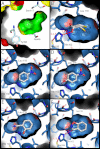Engineering a model protein cavity to catalyze the Kemp elimination
- PMID: 22988064
- PMCID: PMC3479533
- DOI: 10.1073/pnas.1208076109
Engineering a model protein cavity to catalyze the Kemp elimination
Abstract
Synthetic cavitands and protein cavities have been widely studied as models for ligand recognition. Here we investigate the Met102 → His substitution in the artificial L99A cavity in T4 lysozyme as a Kemp eliminase. The resulting enzyme had k(cat)/K(M) = 0.43 M(-1) s(-1) and a (k(cat)/K(M))/k(uncat) = 10(7) at pH 5.0. The crystal structure of this enzyme was determined at 1.30 Å, as were the structures of four complexes of substrate and product analogs. The absence of ordered waters or hydrogen bonding interactions, and the presence of a common catalytic base (His102) in an otherwise hydrophobic, buried cavity, facilitated detailed analysis of the reaction mechanism and its optimization. Subsequent substitutions increased eliminase activity by an additional four-fold. As activity-enhancing substitutions were engineered into the cavity, protein stability decreased, consistent with the stability-function trade-off hypothesis. This and related model cavities may provide templates for studying protein design principles in radically simplified environments.
Conflict of interest statement
The authors declare no conflict of interest.
Figures




Similar articles
-
The response of T4 lysozyme to large-to-small substitutions within the core and its relation to the hydrophobic effect.Protein Sci. 1998 Jan;7(1):158-77. doi: 10.1002/pro.5560070117. Protein Sci. 1998. PMID: 9514271 Free PMC article.
-
Use of stabilizing mutations to engineer a charged group within a ligand-binding hydrophobic cavity in T4 lysozyme.Biochemistry. 2009 Sep 22;48(37):8842-51. doi: 10.1021/bi900685j. Biochemistry. 2009. PMID: 19663503
-
Size versus polarizability in protein-ligand interactions: binding of noble gases within engineered cavities in phage T4 lysozyme.J Mol Biol. 2000 Sep 29;302(4):955-77. doi: 10.1006/jmbi.2000.4063. J Mol Biol. 2000. PMID: 10993735
-
Lessons from the lysozyme of phage T4.Protein Sci. 2010 Apr;19(4):631-41. doi: 10.1002/pro.344. Protein Sci. 2010. PMID: 20095051 Free PMC article. Review.
-
Structural and genetic analysis of the folding and function of T4 lysozyme.FASEB J. 1996 Jan;10(1):35-41. doi: 10.1096/fasebj.10.1.8566545. FASEB J. 1996. PMID: 8566545 Review.
Cited by
-
Enabling protein-hosted organocatalytic transformations.RSC Adv. 2020 Apr 22;10(27):16147-16161. doi: 10.1039/d0ra01526a. Epub 2020 Apr 23. RSC Adv. 2020. PMID: 33184588 Free PMC article. Review.
-
Alteration in the cavity size adjacent to the active site of RB69 DNA polymerase changes its conformational dynamics.Nucleic Acids Res. 2013 Oct;41(19):9077-89. doi: 10.1093/nar/gkt674. Epub 2013 Aug 5. Nucleic Acids Res. 2013. PMID: 23921641 Free PMC article.
-
Catalytic efficiency of designed catalytic proteins.Curr Opin Struct Biol. 2014 Aug;27:113-21. doi: 10.1016/j.sbi.2014.06.006. Epub 2014 Jul 19. Curr Opin Struct Biol. 2014. PMID: 25048695 Free PMC article. Review.
-
A redox-mediated Kemp eliminase.Nat Commun. 2017 Mar 28;8:14876. doi: 10.1038/ncomms14876. Nat Commun. 2017. PMID: 28348375 Free PMC article.
-
Hydrogen Bonding of 1,2-Azaborines in the Binding Cavity of T4 Lysozyme Mutants: Structures and Thermodynamics.J Am Chem Soc. 2016 Sep 21;138(37):12021-4. doi: 10.1021/jacs.6b06566. Epub 2016 Sep 12. J Am Chem Soc. 2016. PMID: 27603116 Free PMC article.
References
-
- Chang CE, Gilson MK. Free energy, entropy, and induced fit in host-guest recognition: Calculations with the second-generation mining minima algorithm. J Am Chem Soc. 2004;126:13156–13164. - PubMed
-
- Cram DJ, Cram JM. Cyclophane chemistry—Bent and battered benzene rings. Acc Chem Res. 1971;4:204–213.
-
- Eriksson AE, Baase WA, Wozniak JA, Matthews BW. A cavity-containing mutant of T4 lysozyme is stabilized by buried benzene. Nature. 1992;355:371–373. - PubMed
-
- Wei BQQ, Baase WA, Weaver LH, Matthews BW, Shoichet BK. A model binding site for testing scoring functions in molecular docking. J Mol Biol. 2002;322:339–355. - PubMed
Publication types
MeSH terms
Substances
Grants and funding
LinkOut - more resources
Full Text Sources
Research Materials
Miscellaneous

